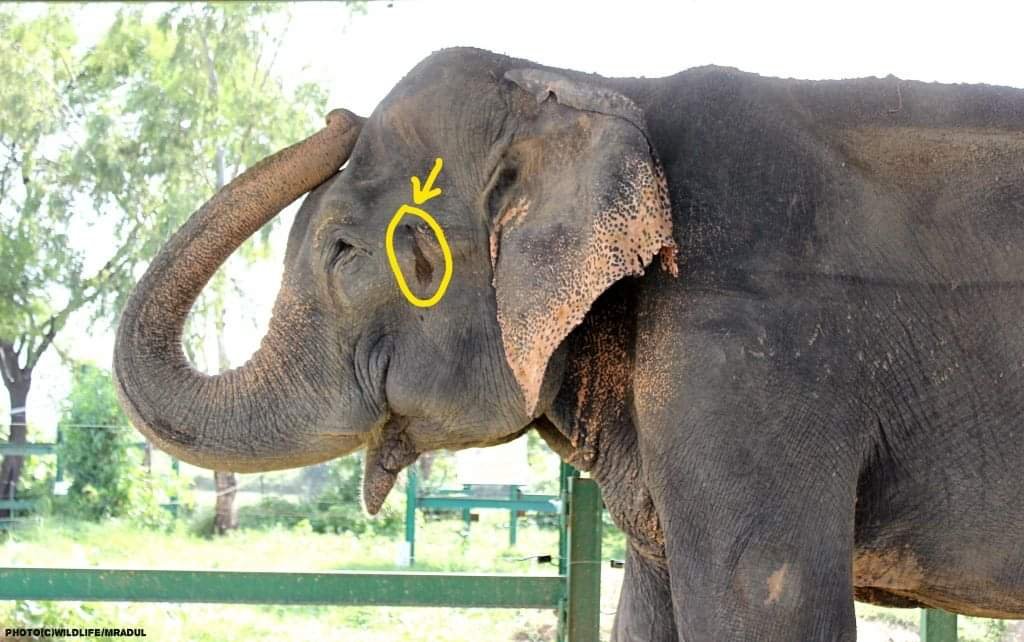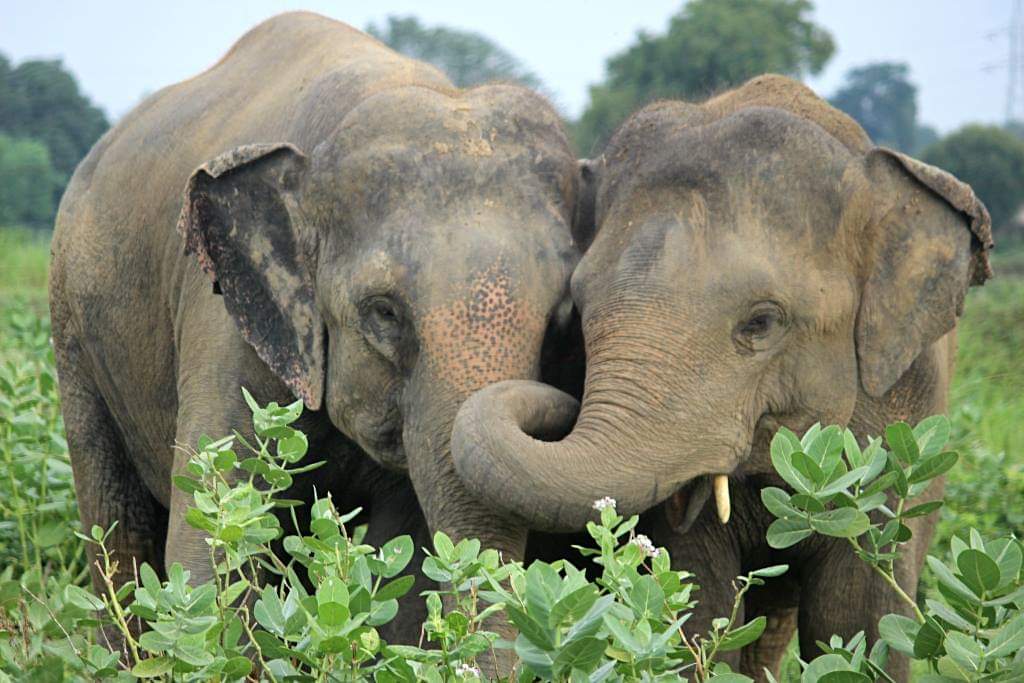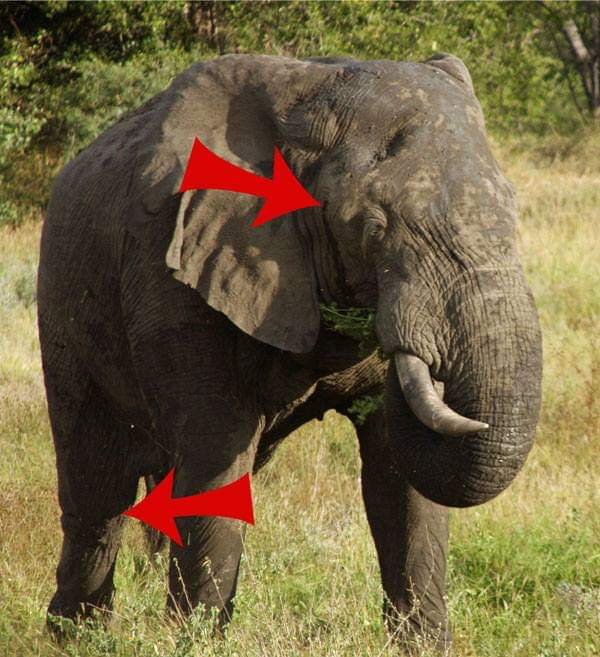Compiled & shared by- DR. Abhishek Kumar, IFS, DFO, JAMSHEDPUR.
Musth is a completely natural phenomenon seen in healthy adult bull elephants, both tuskers and makhnas (tuskless bulls). Generally characterised by the secretion of a hormone rich substance called temporin from the temporal gland (on either side of the elephant’s head) and a steady trickle of urine down the back legs of the elephant, musth involves a rise in the reproductive hormones in the elephant’s body. This causes the animal to feel more restless, energetic, aggressive or unpredictable – and generally irritable and oversensitive to sounds and movements. Musth is seen in healthy adult bull elephants.
How long does musth last?
Is the length and duration of musth a sign of health?
Musth is a natural and healthy phenomenon in adult bull elephants. If a bull elephant goes into musth, it is generally considered a sign that he is healthy. Musth typically lasts between 2-3 months and occurs in three stages – a 3-4 week premusth condition, a 4-5 week peak musth, and a 4-5 week post-musth condition.
For elephants in captivity though, the condition and its duration can vary greatly. Deprivation of food and nutrition can cause the elephant to go into musth less frequently and for shorter durations of time. For bull elephants that have easy access to nutritious food and are in good health, musth can last much longer – records of healthy bulls in captivity have shown them staying in musth for more than a year.
Why aren’t males kept together?
Why don’t they interact as much as the females?
In the wild, female elephants live in herds, and form strongly bonded family units. Males only remain in the herd while they are young, and eventually leave to become solitary animals. Although bull herds have been observed, they are extremely rare. In addition, when bull elephants are mature, they begin going into a periodic phase known as musth, characterised by high levels of testosterone and a spurt in energy, during which they show heightened aggression and unpredictability. Note that musth is perfectly natural in a healthy bull elephant.
When a rescued elephant is first brought to Wildlife captivity rescue centre generally we should give them time to settle in and move past the quarantine period (in case they have infectious diseases that can be passed to the other elephants), and then gradually begin introducing them to the other elephants.
In females, this is always easier, as they find their own friends, families and herd and settle in.
With the males, this has to happen in a controlled environment and never when either male is in musth. Not all males take to each other, and this is perfectly natural for adult bulls, so we do not force interaction either. Some males do interact with each other comfortably, and when neither is in musth, we should take them on walks together.
However, it is always safer and more advisable to keep bull elephants in separate enclosures and limit their interaction to short and carefully supervised sessions.
How are the vets and caretakers able to safely treat and care for a male if he’s in musth? Is he safe to be around?
It is generally not advisable to work with a bull elephant in free contact (ie with direct access to the elephant) if he is in musth as he is prone to aggression and can be easily irritable. However, since our bull elephants are rescued from terrible conditions in captivity, they require constant medical attention and are constantly undergoing some treatment, for which the mahouts and vets need access to them even when they are in musth. In order to do this, our vets work with the bulls in a set up known as protected contact, where a specially designed barrier, called a Protected Contact Wall, separates the vet and the elephant. The elephant is trained using humane and scientific techniques like Target Training and Positive Reinforcement to cooperate during treatment in exchange for treats.
How do you manage and treat an elephant in musth?
When an elephant is in musth, his walks are limited, but he continues to undergo target training and positive reinforcement training in his enclosure. The bulls are restrained during treatment to avoid any threat to the safety of the vet, keeper or elephant. Free access to water is extremely important, to allow the bull to cool down, stay hydrated and expend extra energy. The musth bull’s diet is adjusted to avoid high calorie food.
The bulls are carefully monitored by the vets and keepers to check for any changes in behaviour that could indicate trouble mental and physical health-wise.
How frequently does a bull go into musth?
Musth is an annual phenomena in bull elephants, and generally lasts between 3-4 months, but the duration of musth can vary taking into consideration factors like captivity and the mental and physical condition of the elephant. (See above)
When does a bull start coming into musth?
At what age does a bull elephant stop going into musth?
Young bulls generally start showing musth around 20 years of age.
Musth generally continues till an elephant is about 55-60 years old. However, there is no reliable documentation of the exact average age at which elephants stop showing musth.
Where is the temporal gland located?
 The temporal gland is present on the elephants ‘temple’ area – between the eye and the ear. There is a tiny but visible perforation in the skin at the temporal gland from which a substance known as temporin is secreted when a bull is in musth. This manifests itself as a trickle of liquid down the sides of the elephant’s head, originating from the temporal gland.
The temporal gland is present on the elephants ‘temple’ area – between the eye and the ear. There is a tiny but visible perforation in the skin at the temporal gland from which a substance known as temporin is secreted when a bull is in musth. This manifests itself as a trickle of liquid down the sides of the elephant’s head, originating from the temporal gland.
Does an elephant smell different when in musth?
Does it smell to anyone other than a female elephant?
Musth fluid/secretion or temporin has a distinctive strong odor which can be smelled by human beings as well. It is however easier for female elephants to smell temporin and use it to determine the sexual maturity and condition of the male- this is because the sense of smell of an elephant is much more developed than that of a human being.
Are there signs (physical or behavioural) of musth?
Generally characterised by the secretion of a hormone rich substance called temporin from the temporal gland (on either side of the elephant’s head) and a steady trickle of urine down the back legs of the elephant, musth involves a rise in the reproductive hormones in the elephant’s body. This causes the animal to feel more restless, energetic, aggressive or unpredictable.
What changes are made to an elephant’s diet when it is in musth?
Our bulls continue on their regular diet when they are in musth. They are given nutritious green fodder and fruit and vegetables everyday along with vitamin and mineral supplements in a concentrate bolus of horse gram porridge and jaggery.
Do castrated elephants come into musth?
An elephant that has undergone a vasectomy would come into musth as the procedure does not affect hormonal changes in the body. Castration is extremely difficult in elephants due to the depth of the location of the testicles within the elephant’s body. However, elephants are rarely castrated as this is an extremely complicated process, and illegal elephant owners often breed their elephants in captivity and hence would not benefit from castrating them.
MYTHS OF MUSTH:
Musth is a natural phenomenon of nearly every healthy male elephant the age of 18 years and above. With some elephants their behaviour and personality do not change, that is they do not become aggressive, but most elephants experience a behavioural shift and become stubborn, dangerous, and aggressive for a period of one to four months until the condition runs its course. The musth fluid that flows has a foul smell and has a grey or dark grey colour. Aggression can be directed at the mahout, at any and all humans, or at other elephants, even cow elephants. Some elephants will tolerate humans and be aggressive only to other elephants. Some male elephants from about the age of twelve years and up begin to show signs of musth. If the elephant is in good health and has been receiving abundant food and water, and sufficient rest, that first musth is called “grass musth” (tok man yaa). “Grass musth” [honey musth] is shown by a secretion oozing from the temporal gland and agitation and stubbornness in the animal’s behaviour. Sometimes such elephants will play very roughly or injure other elephants or their keepers — but this is not the same strength as true musth. Elephants will generally come into true musth about 4 or 5 years after the first “grass musth”. Sometimes female elephants which are fat and healthy will also come into “grass musth”, most often when some outside influence makes them nervous or before giving birth. The secretion exuded is greyish and pasty without a particularly bad smell. Beyond some agitation, there are few of the behavioural problems posed by males in true musth. Coming into musth (1 – 5 days) The elephant’s neck will thicken (as felt by the mahout on the neck) and the elephant will seem fatter. The temporal gland on the forehead swells and seepage begins. The elephant will resist authority and become stubborn, refusing orders. The elephant’s eyes will change to become very alert, staring for a long period of time at the mahout, at other elephants, or at something else.
The penis frequently becomes erect, and the elephant will slap it up into its belly while at the same time urinating in a dribbling manner. Finally, the elephant becomes listless and begins to eat less. Full musth (1 – 5 months) The temporal gland swells greatly, and there is a smelly secretion that exudes in increasing quantity. Sometimes the secretion actually flows into the mouth. The penis is continually erect, secreting a stinky, mucous-like substance that falls onto the hind legs, making them moist, in a condition called long bawng [green penis syndrome]. The elephant will be aggressive and will not recognize its mahout and elephants it has known. The mahout and others near the elephant must be very careful at all times. Ending of musth (2 weeks – 2 months) The temporal gland will shrink back to normal at the same time as the amount of secretion reduces. The elephant becomes more peaceful and begins to follow the mahout’s orders. The elephant is normal.
Preparing for musth When the elephant shows the very earliest signs of musth, the mahout should chose a site and prepare as follows:
Select a tethering place that is quiet and apart from other elephants. Critically important is to keep at a distance people who have no duties with the elephant. The tethering site must be cool and in the shade all day long. The tethering place should have clean water that flows continually. If this is not possible, it must be possible to bring clean water so the elephant can bathe and drink safely and conveniently every day. The tethering place must be smooth, with no holes or depressions and no garbage and sharp edges dangerous to the elephant.
Choosing a site on a slight rise is extremely important because that will facilitate drainage of rain, of bathing water, and most particularly of the elephant’s urine. Good drainage will also minimize the ill effects of foot and nail problems that can arise when a musth elephant is confined for months to a wet or muddy place. Similarly, choosing a site that has soil that absorbs water well is very useful in forestalling foot and nail problems. For safety, there should be a tree or some other secure tethering point that is strong enough to hold the elephant. All of the equipment used for musth elephants must be strong enough to withstand the elephant’s strength and must be readily at hand. Every link in the tethering chain should be carefully inspected, the swivel should be strong and not defective, moving freely. The U-bolt should be oiled so that the post screws easily and securely into the threaded holes. Consideration should be given to providing musth elephants with special foods. Diet in musth When the elephant is in musth, the most appropriate food has low nutritional value, such as banana tree stalks (always cutting it to about a hand’s length before feeding), green squash (fak khiow), and dried grass (which can be sprinkled with salt water to improve palatability), because such foods have a low nutritional value. When the elephant eats such food, it will feel full very quickly. Other foods are possible but the amounts given should be decreased from when the elephant is not in musth. High-energy foods such as unhusked rice, sticky rice, etc., should be absolutely avoided. High-energy foods are in no way dangerous to the elephant’s physical health, but feeding high-energy foods will ensure that the musth period will endure much longer than if provided with foods with low caloric value. Low value foods in the proper amount will keep the animal in good health and will also give it the contentment of eating and having a full belly
Warning: It is important that a musth elephant be given sufficient clean water.
Reference:Source- wildlife sos




